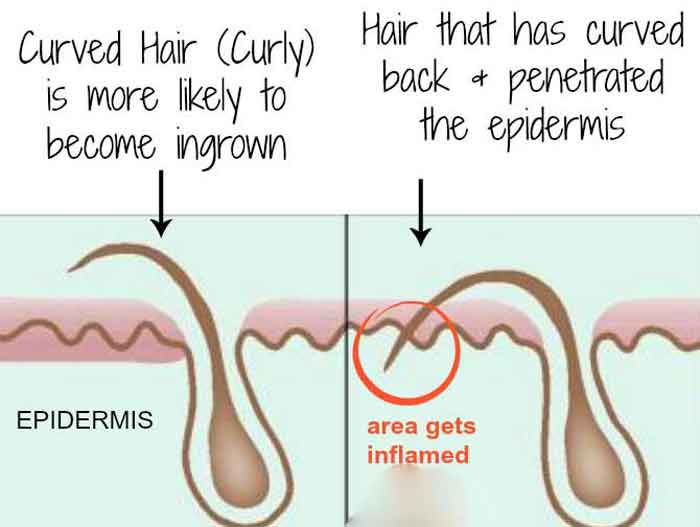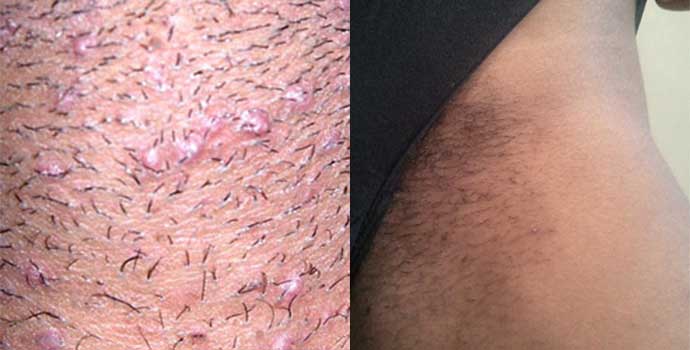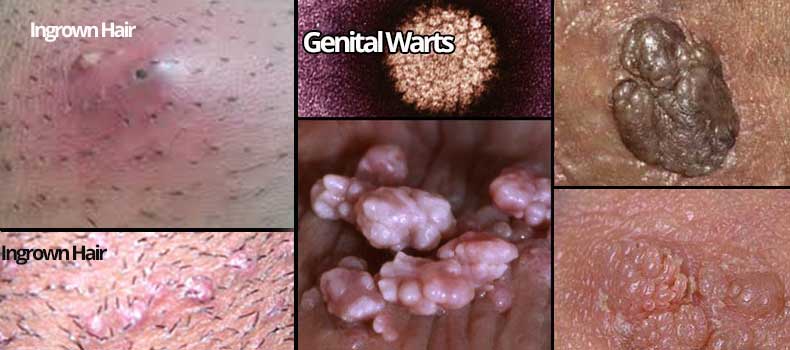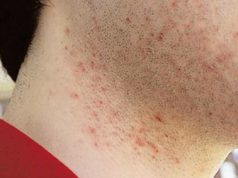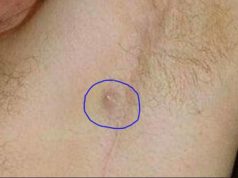For most women, ingrown hair on privy area is such an irritating condition. Herein, find the causes, symptoms pictures of inward growing or embedded hair.
In addition find, treatment, how to prevent and how these ingrown hair bumps can differentiated from STDs such as herpes, genital warts and cysts
Causes
What causes ingrown hair on female genitalia? Below is a discussion of the female external genital organs and how ingrown hair develops around this area.
Many are times when you refer to the female external organs as the ‘v’. The pudendum is the correct term in reference to the whole area.
The pudendum is comprised of the following parts as shown in the illustration

Aggressive hair removal procedures
The main cause of ingrown hair in in the area is repeated and aggressive hair removal methods. These shaving methods include;
- Waxing,
- Tweezing
- Plucking
Poor shaving & use of inappropriate shaving tools
Shaving may be so when it is done poorly.
Shaving in a hurry
when you shave in a rush, you are likely to forget the rules of shaving and probably become too aggressive on your skin.
Shaving without wetting the hair and the skin
This increases the chances of getting a broken skin that would allow the hair to stick in and in grow. Shaving when you get to the shower bears the same risk.
Use of inappropriate shaving tools such as an old razor
using a blunt or old razor may lead to a rash or razor burn. They are rough on the skin are likely to have hair coil around it.
Curly and coarse hair
If you have hair that curves backwards naturally and at the same time, coarse, chances are that you may get ingrown hairs.
Not trimming the hair firsthand
The reason your hair gets ingrown is due to the curling and curving of the top part of the shaft. Before you decide to pass a razor on the hair shafts, it is recommended to trim your hair firs so that they are straight and well-spaced out.
According to ‘Lipstick’, if your hair has grown longer than a ¼ an inch, you should trim it back shorter. This will save you time too.
Bikini area clogging up of skin pores
when you wear bikinis which are tight, especially when you are done with shaving, your risk ingrown hairs. Tight clothing are especially prone to pressing the hair follicles on the skin and resulting in hairs that curve backwards and enter the skin. Those that are big culprits include those with les elastic bands.
Pregnancy and menstrual period
Hormonal changes can also lead to ingrown hairs. This is due to depression that is associated with these physiological changes. When your skin is forced to produce more sebum as does during pregnancy, then there might be clog up of the skin pores.
Symptoms
How does an ingrown hair on the private regions look or feel like? The following symptoms will be able to guide you. The symptoms in relation to genital herpes and warts have been discussed in the sections below.
- Bump with a black dot at the center – this is the typical razor burn that you get on any part of your body with ingrown hair.
- Pain and tenderness – the pain emanates from the inflammation and stretching of the skin when the bump is growing. At times the bump sits on the nerves and causes nerve pain.
- Irritation and itchiness– this is common especially around the bump. The center is painful but at times you are tempted to scratch your periphery especially when it is healing. Mostly affects the inner thighs.
- Bumps or lumps that are red, white or yellow in genital area – typical of an infected ingrown hair. The color varies according to the extent of infection.
- Complication may lead to a pus filled cyst– the infected bump, now a boil may turn into a cyst which is more painful and demands a lot in terms of treatment.
- Post inflammatory hyperpigmentation and scars – this occurs as a result of deposition of keratin as the boil heals.
Pictures, Near, on & Inside
Below is a gallery showcasing how inward growing looks like in, on or near the pudendum
Pic #1
Pic #2
Pic #3

Ingrown Hair on or STDs
Genital warts are also referred to as condyloma acuminata or venereal warts. At times you may confuse ingrown hairs with genital warts.
According to Mayo Clinic, genital warts can also be easily confused for bumps caused by herpes.
Here are some differences between ingrown hair bumps and genital warts:
- Flesh-colored gray growths in the genital area
- Genital warts are commonly transmitted via sexual means and is a virus infection. The virus responsible is the human papilloma virus[2]. This may either be the HPV-6 or -11
- They are highly contagious and there is a very high risk of contracting it from a single sexual contact with an infected person.
- Fever as a sign of infection
Genital herpes can also be differentiated from ingrown hairs in the following ways:
- Genital herpes is also a sexually transmitted disease caused by the herpes simplex virus (HSV).
- There has to be a broken skin or mucous membranes for this virus to cause herpes.
- Herpes simplex virus causes sores on the genital areas be it HSV-1 or -2.
- Painful blisters or ulcers in the genital areas that are close set.
- Burning or tingling sensations on the skin
- Fever
- Swollen lymph nodes
- Body aches
How to Treat & get rid of Fast
If you have a few ingrown hairs, then consider removing them with DIY procedures at home. Proper care and removal of the embedded hairs would be a good and easy solution if you have no recurring ingrown hairs on the area.
- Clean your genital area with warm water or gentle soap. You can also use an antiseptic solution.
- Apply some anti-inflammatory remedies days before the procedure to reduce the inflammation.
- Warm compress days before too and the day or removal. More on warm compress coming up shortly
- Use your sterilized tweezers to pull out the hair follicle if you see it.
- After removal treatment with some antibacterial ointment and some disinfectant.
Further Reading:
Other Treatment Options
To treat the ingrown hair particularly to alleviate the pain and treat the infection, this is what should be taken or done.
- Retinoids – such as retin A can be administered to remove dead skin cells and reduce hyperpigmentation that occur with ingrown hairs. It also promotes replacement of dead skin cells.
- Hydrocortisone cream 1% – apply to reduce the inflammation and improve wound healing. Apply twice a day and as recommended as withdrawal from the medication should be a gradual process with reducing the doses in a tapering fashion. Consult your pharmacist.
- You will get antibiotics prescribed for you if you have an infection. Do not take antibiotics without a diagnosis and if so, make sure that you complete your full course.
- To exfoliate and remove dead skin cells, use salicylic acid or benzoyl peroxide.
Home Remedies
Other methods you can use to get rid of ingrown hairs at home include:
Applying turmeric to the inflammation
Making a paste of turmeric will aid in the reduction of inflammation. Turmeric has anti-inflammatory properties brought about by its active principle, curcumin. Cineole again has antimicrobial properties. Making a paste with water and applying then leaving to stay for a while will relieve the inflammation.
Applying some rose water
Rose water is another known anti-pruritic. It is also a cleanser. Its anti-inflammatory properties can come in handy in the treatment of ingrown hairs on the mon pubis too.
Applying some tea tree oil
It is obtained from tea leaves. It is obtained by steam distillation of the leaves of Melaleuca alternifoliate. It is especially good for its healing properties on the skin and scalp infections. In ingrown hairs, it will help clean the hair follicles due to its antiseptic properties.
Tea tree oil further facilitates rejuvenation of skin cells. It contains chemicals which have anti-inflammatory properties. To use it, warm the oil and mix it with a carrier oil then apply.
Warm compressing
Warm compressing allows the hair embedded to come above the skin. To do this, wet a wash cloth by dipping it in hot water, wring it then place on the affected skin. Once cold, return it in the hot water then repeat the procedure again. Do this until you can be able to see the hair then coax it out.
Sugar scrub
Sugar scrub contains glycolic acid. It is an effective exfoliating agent. It also has some anti-inflammatory activity.
The importance of the exfoliating activity comes in handy when removing dead skin cells from clogging the pore. To prepare this, add two tablespoonfuls of sugar to olive oil then rub around the ingrown hair bump.
Using black tea bags
These bags have tannin which is a known anti-inflammatory. It is placed over the area affected for 15 to 30 minutes. It will reduce the redness and swelling associated with ingrown hairs.
Applying some Aloe vera
Aloe vera has myriads of activities. It has both anti-inflammatory and antimicrobial activity. It has stimulating effects on wound healing (T. Reynolds and A. C. Dweck, 1999)[3].
Applying some honey
Honey has antibacterial properties. It also has soothing effects on the skin being able to alleviate the irritation that accompanies ingrown hairs. It also moisturizes the skin and reduces inflammation. To use it apply some on the area that has some irritation and let it dry.
Leave for about 15 minutes then rinse off. You can also add an essential oil of your choice.
Apple cider vinegar
ACV stimulates the flow of blood to the follicles.
It is good for the rejuvenation of the skin cells (The Derma Doctor Skin Struction Manual, 2005). This is because it contains malic and acetic acid which also may help in the removal of dead skin cells through exfoliation.
It is able to counter inflammation and has antibacterial properties. To use it for itch, mix it with an equal volume of water and apply then leave it to dry. You could also use a cotton ball, dip it into the ACV then hold for 15 minutes. Do this daily until there is improvement on the ingrown hair bump.
Tips to Prevent Ingrown Hair
- Avoid frequent and aggressive hair removal in the genital area – this is the best way to avoid ingrown hairs. This will minimize the chances of ingrown hairs occurring
- Opt for trimming rather than shaving– this will make you avoid shaving too close to the skin which poses a risk of ingrown hairs. Use a pair of scissors or any other equipment to shave and trim.
- When shaving avoid old, blunt and overused razors. Use sharp, and sterilized equipment.
- When you get ingrown hairs, make sure that you treat it properly.
- Moisturize your skin to hydrate the skin cells – this should be done especially before you shave. While shaving follow the same direction the hair is growing to avoid damaging the hair follicle which could result in an ingrown hair.
- You can consider a laser hair removal method. This is a long lasting hair removal method. The method is used to remove hair at a deeper level. It is an effective method of preventing hair from growing back. This method should be performed by a profession as added treatment s required over the cause of several months.
- In addition to laser as an alternative hair removal procedure, you can consider using creams. Note that the chemicals found in these creams can be very irritating to the skin of some people. Do consult with your doctor before use.
Sources
[1] http://www.sexualhealthaustralia.com.au/female_anatomy.html
[2] http://www.emedicinehealth.com/genital_warts/article_em.htm
[3] T. Reynolds and A. C. Dweck. J. Ethnopharmacology,, 1999, 68, 3.

